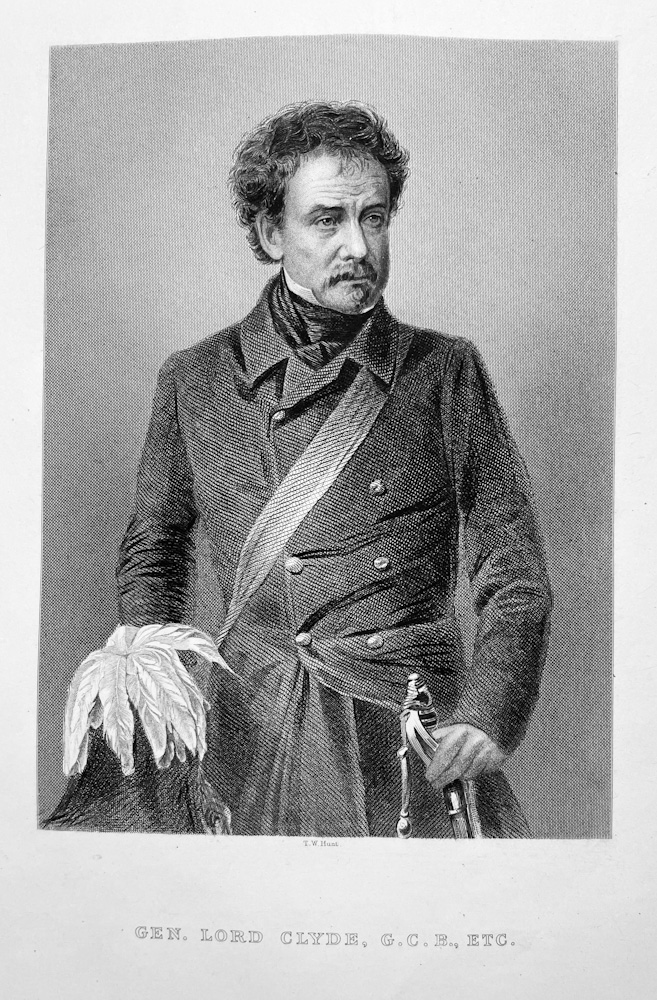GEN. LORD CLYDE, D. C. B., ETC. Artist: unknown ____________ Engraver: T. W. Hunt |

We pack properly to protect your item!
PRINT DESCRIPTION:
Field Marshal Colin Campbell, 1st Baron Clyde GCB, KSI (20 October 1792 – 14 August 1863) was a British Army officer from Scotland who led the Highland Brigade in the Crimea and was in command of the ‘Thin red line’ at the battle of Balaclava. He later commanded the relief army in the Indian Rebellion of 1857. Campbell served in Nova Scotia with the 7th Battalion, 60th Regiment in the War of 1812. After the peace of 1815, he devoted himself to studying military science. In 1823, he quelled the slave rebellion in Demerara, and two years later bought himself a major's rank. In 1832, he became lieutenant-colonel of the 98th Foot and rendered distinguished service in 1842 during the First Opium War. Campbell next saw action in India, in the Second Anglo-Sikh War of 1848-1849, under Sir Hugh Gough. He was wounded at the battle of Chillianwala. At the decisive victory of Gujrat, his skill and valour contributed largely to the success of the British forces; his "steady coolness and military precision" were highly praised in official despatches. He was made a Knight Commander of the Order of the Bath in 1849, and specially named in the thanks of Parliament. After further service in India, Campbell returned home in 1853. The next year, the Crimean War broke out, and he accepted the command of the Highland Brigade, which formed part of the Duke of Cambridge's division. The brigade and its leader distinguished themselves very greatly at the Battle of Alma; and with his "thin red line of Highlanders" he repulsed the Russian attack on Balaclava. At the close of the war, Sir Colin was promoted to Knight Grand Cross of the Bath, and elected honorary D.C.L. of Oxford University. His military ability had been late in being recognised; but his true worth was soon appreciated. In 1857 what started as a rebellion of sepoy soldiers in India spread to a general insurrection in the north of the areas of India controlled by the East India Company. The initial successes of the rebellion led Lord Palmerston to offer him the command of British forces there on July 11, 1857. On being asked when he would be ready to set out, Campbell replied, "Within twenty-four hours." He left England the next evening, and reached Calcutta on August 13. After spending over two months in the capital to organize his resources, he started for the front on October 27, and on November 17 relieved Lucknow for the second time. Campbell, however, considered Lucknow a false position, and once more abandoned it to the rebels, retaking it in March 1858. He continued in charge of the operations in Oudh until the embers of the revolt had died away. For these services he was raised to the peerage in 1858 as Baron Clyde, of Clydesdale in Scotland. After returning to the United Kingdom in the next year, he received the thanks of both Houses of Parliament and a pension of £2000 a year. He was promoted to Field Marshal in 1862. Despite lacking the dash which won Britain so many victories in India, Campbell was regarded as a brave soldier and a careful and prudent leader. The soldiers whom he led were devotedly attached to him; and he commanded unvarying respect. Nicknames given by those who disliked his safety-first style of generalship, included 'Sir Crawling Camel' and 'Old Slowcoach'. Lord Clyde never married and the barony became extinct on his death in August 1863, aged 70. He was buried in Westminster Abbey. A statue was erected to him in his native town, (see Glasgow's public statues) from whom he had also received the Sword of Honour, one of many he received from throughout Britain. Another statue of him, by Carlo Marochetti, was erected in Waterloo Place, London, in 1867. The town of Clyde, New Zealand was named after him in 1865. The town of Campbellpore (Campbellpur), Attock in present day Pakistan, was named after him in 1908.
A FAMOUS HISTORICAL MOMENT, BATTLE SCENE, EVENT OR PORTRAIT OF A FAMOUS PERSON FROM ENGLAND’S PAST!